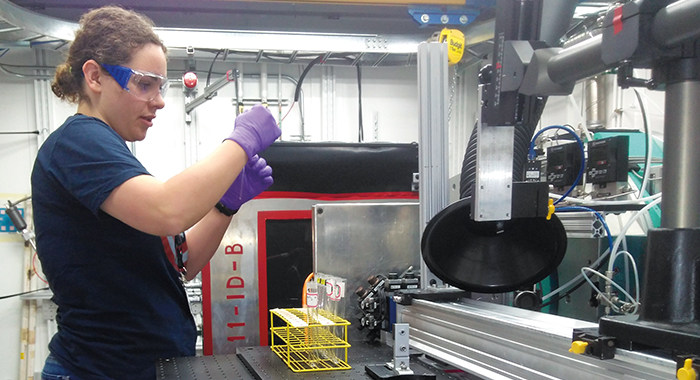Battery-Powered Summer Fuels Research
Most college students pull all-nighters. Few do so in a national laboratory, conducting high-stakes experiments using billion-dollar equipment.
In addition to taking part in an extremely competitive National Science Foundation (NSF) program, Alexis Puyleart ’19 spent part of her summer conducting round-the-clock experiments at the Argonne National Laboratory.
Puyleart is partnering with Nick Mauro (Physics), who has received approval from the Department of Energy to use the high-tech X-Ray machine at Argonne National Lab in Illinois. It’s one of few places in the world that has the equipment Mauro needs for experiments in a research initiative that, ultimately, will contribute to improved batteries.
“It’s really hard to get beam time on these things,” Mauro says. “More to the point, it’s a really unique experience. These are 24-hour-a-day experiments, and so the preparation that goes into these things is very intense. It’s not like research in a lab here where you can screw up three times, screw up four times. … You only have 24 hours.”
Before Mauro, the newest member of the physics faculty, arrived at St. Norbert, Puyleart had already been accepted to one of the handful of Research Experience for Undergraduates programs funded each year by the NSF. She was one of eight students to be accepted out of hundreds of applicants nationwide to a program that assisted Ralph Wheeler, professor of computational chemistry at Northern Illinois University (NIU). Coincidentally, Wheeler and Mauro were already working together, members of a five-person team researching electrolytes, a component of ion batteries.
This summer, Puyleart and her newest professor headed to Argonne for two experiments: one 48-hour experiment in which Puyleart took the 12-hour 2 a.m. shift, and one 24-hour experiment when Puyleart worked straight through.
“Being able to do research for a few hours is one thing, but being able to fully immerse yourself in the field that you love and the field that you’re studying for 24 hours straight, with multi-million-dollar equipment, it was huge,” Puyleart says.
Mauro adds: “It was challenging, and it was stressful. And it was great, and it was terrible. And it was fun, and it was exhausting. But at the end of it, she did really well.
“It’s science on a scale most students don’t get to experience. You simply do not get these experiences very often. So, to be able to capitalize on them is super-important.”
Oct. 31, 2018












